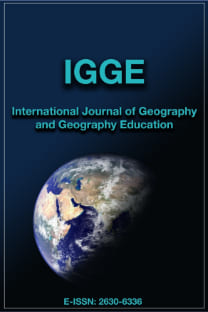LOJİSTİK COĞRAFYASI ÜZERİNE BİR DEĞERLENDİRME
Coğrafya, Lojistik, Lojistik Coğrafyası, Nakliye ve Yer Seçimi
-
Geography Logistic, Logistic Geography, Transportation, Site Selection,
___
- Akyıldız, M., (2004). “Lojistik Dış Kaynak Kullanımının Gelişimi ve Türkiye’deki Kullanım Biçimleri” Dokuz Eylül Üniversitesi Sosyal Bilimler Enstitüsü Dergisi, Cilt 6, Sayı 3, s.1-22.
- Alpugan, O., (1996). İşletme Bilimine Giriş, Derya Kitapevi, Trabzon. Arnold, D.,( 1995). Coğrafi Keşifler Tarihi. Çev, Bahadır, O., Alan Yayıncılık, İstanbul.
- Askeri ve Teknik Sözlük. (1950), Genel Kurmay Başkanlığı Yayınları, Ankara.
- Ceran,Y., ve Alagöz, A., (2007). “Lojistik Maliyet Yönetimi: Lojistik Maliyetler ve Lojistik Maliyet Muhasebesi” Yönetim Bilimler Dergisi, sayı 5:2, s.153-175
- Ekinci, M. B., (2008). Uluslararası Hizmet Ticaretinde Gelişmekte Olan Ülkeler ve Türkiye. İTO Yayınları. İstanbul.
- Filik, F., (2011). Lojistik Merkezlerin Rolü ve Önemi. M. Tanyaş, ve K. Hazır (Ed.), Lojistik Temel Kavramlar. S.199-251. Cağ Üniversitesi Yayınları, Tarsus.
- Fleet, K., (2009). Erken Osmanlı Döneminde Türk-Ceneviz Ticareti. Çev, Akpınar,Ö., Türkiye İş Bankası Yayınları, İstanbul.
- Gülen, K. G., (2011). Lojistik Sektöründe Durum Analizi Ve Rekabetçi Stratejiler, Ticaret Odası Yayınları, İstanbul.
- Güven, İ., (2010). Yeni ve Yakınçağ. İ. Güven ve Ü. Akagündüz (Ed.), Uygarlık Tarihi. s.333-382, Pegem Akademi Yayınevi, Ankara.
- Hançerlioğlu, O., (1982). Ticaret Sözlüğü, Remzi Kitapevi Yayınları, İstanbul.
- İstanbul Ticaret Odası., (2006). Türkiye Lojistik Sektörü Altyapı Analizi, Entegre Matbaacılık. İstanbul.
- Karacan, S., ve Kaya, M., (2011). Lojistik Faaliyetlerde Maliyetleme, Umuttepe Yayınları. Kocaeli.
- Kobu, B., (1979). Üretim Yönetimi, İstanbul Üniversitesi Yayınları, İstanbul.
- Küçük, O., (2011). Lojistik İlkeleri ve Yönetimi, Seçkin Yayıncılık, Ankara.
- Murat, S., ve Şahin, L., (2010). Dünden Bugüne İstanbul’da Ulaşım, İstanbul Ticaret Odası Yayınları, İstanbul.
- Newman, W. H., (1979). Yönetim, İşletme Ve Kamu Yönetiminde Sevk Ve İdare. Çev, Sürgit, K., Türkiye ve Ortadoğu Amme İdaresi Enstitüsü Yayınları, Ankara.
- Öz, M., (2011). “Lojistikte Yeni Yaklaşımlar” Kahramanmaraş Sütçü İmam Üniversitesi İİBF Dergisi. Sayı 1, s.141-155
- Özey, R., (2013). Ticaret Coğrafyası ve Küreselleşme, Aktif Yayınevi, İstanbul, s.84
- Tanyaş, M. ve İris, Ç., (2010). Türkiye Lojistik Raporu 2010, MÜSİAT Sektör Raporları, Mavi Ofset Basım Yayın, İstanbul.
- Tanyaş, M. ve Paksoy, T., (2012). Konya- Karaman Bölgesi, Lojistik Strateji Planı Ön Hazırlık Raporu 2012, MÜSİAD, Konya. Taşdemir, M., (2012). Osmanlı’da Ulaşım. V. Engin, A.Uçar ve O, Doğan (Ed), Çamlıca Basım Yayım, İstanbul.
- Timur, N., (1988). Sanayi işletmelerinde Lojistik Faaliyetlerin Organizasyonu, Anadolu Üniversitesi Yayınları, Eskişehir. Tümertekin, E., (1976). Ulaşım Coğrafyası. İstanbul Üniversitesi Yayınları, İstanbul.
- Tümertekin, E., ve Özgüç, N., (1997). Ekonomik Coğrafya, Küreselleşme ve Kalkınma, Çantay Kitabevi, İstanbul.
- TÜSİAD., (2007). Kurumsal Yapısı, Yasal Çerçevesi ve Göstergeleriyle Ulaştırma Sektörü, Mikado Matbaacılık, İstanbul.
- Yayın Aralığı: Yılda 3 Sayı
- Başlangıç: 1996
- Yayıncı: Marmara Üniversitesi
SOSYAL BİLGİLER ÖĞRETİMİNDE MÜZE GEZİLERİNİN TARİHİ VE KÜLTÜREL DEĞERLERİN KAZANDIRILMASINDAKİ ÖNEMİ
COĞRAFYA ÖĞRETMENLİĞİ YÜKSEK LİSANS PROGRAMI ÖĞRENCİLERİNİN YÜKSEK LİSANSTAN BEKLENTİLERİ
MODA-CADDEBOSTAN (KADIKÖY) ARASI KIYI ALANINDAKİ DEĞİŞİMİN İNCELENMESİ
Nuriye GARİPAĞAOĞLU, Sibel ÖZCAN, Murat UZUN
COĞRAFYA LİSANS ÖĞRENCİLERİNİN MEZUNİYET SONRASI KARİYER PLANLARINA İLİŞKİN GÖRÜŞLERİ
ISPARTA İLİ MİLLİ PARKLARININ REKREASYONEL FAALİYETLERDE KULLANIMI
İsmail KERVANKIRAN, Adile ERYILMAZ
COĞRAFYA DERS KİTAPLARINDA AKTİVİTE İLKESİNİN İNCELENMESİ
Hamza AKENGİN, Gülten YILDIRIM, Zafer İBRAHİMOĞLU, Seyfettin ARSLAN
KÜLTÜREL MİRAS KAYNAĞI OLARAK KÖPRÜBAŞI İLÇESİNDE (TRABZON) GELENEKSEL TAHTA KAŞIK ÜRETİMİ
COĞRAFİ ORTAM VE KENT FİZYOLOJİSİ İLİŞKİLERİ: XIX. YÜZYIL KİLİS ŞEHRİ ÖRNEĞİ
